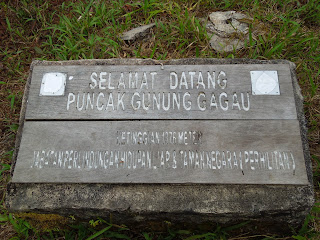A stream flowing to the main river - be warned, the water after 'Kem A' is brick-red colored to the top
The hiking from Taman Negara Terengganu (the most cosy yet most challenging) starting from Sungai Cicir to the mountain top will take you about 15 km to the top. There are two campsite along the way - the first one is Kem A usually known as Kem Sungai Pakchau - at elevation of 315m (asl), following by Kem Cicir B situated at 690 (a.s.l) - from here, the water turn red all the way to the top and you'll find no fish at all in the stream.
The skyview at Kem Cicir B - I was suprised to saw a Grey-headed fish eagle cross the sky - the obstruction is not so dense, at least 4 hornbill species is a must, I had recorded banded pitta
The stone marking the boundary of three states at 1180
The top of Gunung Gagau
In terms of birds, the first hike from starting point to Kem A relatively dead, once in a while birds like paradise flycatcher, cream vented bulbul and blue flycatcher would appear crossing the trails, Great Argus call is common and at before noon, in a clear spot, crested serpent eagle and fish-eagle usually appeared.
At Kem A, some highlighted bird are including Garnet pitta, blue wing leafnird and white crowned forktail.
At Kem B, changes in elevation doesn't translated well for bird species, but the clear view to spot a foraging bird will be better. Montane species appear at elevation of 1000m (asl) upward, where species such as mountain warbler, lesser-racquet tail drongo and mountain bulbul appeared.
At Kem A, some highlighted bird are including Garnet pitta, blue wing leafnird and white crowned forktail.
At Kem B, changes in elevation doesn't translated well for bird species, but the clear view to spot a foraging bird will be better. Montane species appear at elevation of 1000m (asl) upward, where species such as mountain warbler, lesser-racquet tail drongo and mountain bulbul appeared.
one of those
Basically the humidity above 800m in this mountain is high and sometime fog can be thick especially during the rain. It is wise to bring along anything essential to keep the gear dry. The best time in the year to visit this area is during April to June, when rain is less likely spoil your trip. Late october and early november might be the best time to visit this site for migrating season period.
foggy - 1023a.m





